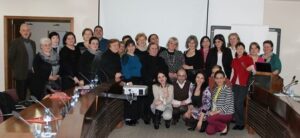The art of gender integration in non-communicable disease improvement activities
By Taroub Harb Faramand, MD, MPH on June 30, 2014
Globally, there are disparities in the prevalence and treatment of non-communicable diseases (NCDs) among men and women, and there is still a shortage of rigorously analyzed sex-disaggregated data related to NCDs, which makes it difficult to accurately determine the influence of gender-related factors on NCD morbidity and mortality and to establish the extent to which disparities in treatment exist.

A recent two-part series by CBS’s 60 Minutes, titled Sex Matters exposed the lack of sex-disaggregated medical data as a critical issue affecting heart disease diagnosis and other NCDs. This makes the work our USAID ASSIST team is doing to integrate gender into NCD services in the Republic of Georgia all the more innovative and meaningful. This past February I had the opportunity to travel to Georgia to work with Dr. Tamar Chitashvilli, ASSIST Chief of Party in Georgia, and her team, to provide technical assistance to integrate gender into the ASSIST-supported NCD program. I participated in a learning session, led a session to train participants on gender integration in NCD improvement activities, and developed recommendations for gender integration moving forward.
The 8th learning session in Kutaisi was characterized by high enthusiasm, and Dr. Chitashvilli presented compelling results. Participants shared success stories and discussed what has worked and what has not. I tailored the gender integration training at the learning session to be relevant to the discussions and issues which I heard from the participants throughout the learning session. I specifically focused on NCDs and risk factors.
As I explained what I would be discussing during the training and engaged with participants about their expectations, I was not surprised to find out that many participants expected this gender training to only be about women’s empowerment or about changing roles of men and women. This is quite a common assumption I come across when I conduct gender trainings all over the world: there is a notion that gender only means women and women’s empowerment. Gender reflects the relationship between males and females and the expectations and limitations that society puts on males and females because of their sex. I make this clear at the beginning of every gender training I conduct.
Through the USAID ASSIST Project, our goal in integrating gender is to improve health outcomes by addressing the specific needs of women, men, girls, and boys. We use improvement approaches to integrate gender, by identifying gaps in access and utilization of services that affect health outcomes of males and females, and we support field office staff and local partners to identify changes to test to overcome barriers, to close gaps and to achieve improved health outcomes.
Closing gaps in health outcomes between women and men leads to more equality. By developing practical scenarios and exercises based on previous materials presented during learning sessions, and tying gender integration to health outcomes and improvement, the training was very successful. Participants expressed how they changed their view of gender and gender integration. I received feedback that our approach is very clear and relevant to their work.
In addition to conducting a gender training, I provided support to the Georgia field office to analyze data and identify gender-related gaps by examining how men and women access and utilize care and treatment related to cardiovascular disease (CVD), asthma, hypertension, diabetes, and cancer; and how physicians provide counseling differently to men and women in relation to those risk factors in Georgia.
Two interesting gender-related gaps were identified in cholesterol and cardiovascular disease screening. A baseline conducted by the USAID ASSIST-supported NCD Project in Georgia found that men were more than twice as likely to report having their cholesterol measured within the past 5 years, and men were also much more likely to have been told they have high cholesterol. Yet a 2010 population study found that a larger proportion of women have high cholesterol than men in Georgia, suggesting that a portion of women who have high cholesterol are not accessing and receiving the proper care and treatment.
Another interesting gap that the USAID ASSIST team identified was in CVD risk calculation: 88% of female patients had their 10-year CVD risk calculated, while 96% of male patients had their CVD risk calculated this past February at supported facilities in Georgia. This could be because of a provider bias that CVD is more prevalent in men than in women, and suggests that a portion of women who are at a high risk of CVD are not receiving the proper health services and treatment.
The ASSIST-supported Georgia team has worked to increase cholesterol testing rates and CVD risk calculation rates of males and females, with a focus on closing the gap and ensuring equality of treatment. Cholesterol testing rates had increased substantially for both men and women, and the gap between male and female cholesterol testing rates decreased substantially. Screening and management of CVD risk factors in primary care and in selected ambulatories has also increased dramatically, and the ASSIST team in Georgia is currently implementing gender-sensitive interventions to close the gap in this very important screening process, considered a best buy by WHO. We are all very much awaiting the endline results from this intervention.
For more discussion on how gender considerations can improve NCD services, see the Addressing the Unique Needs of Women and Men in Non-Communicable Disease Services technical brief published in May 2014.